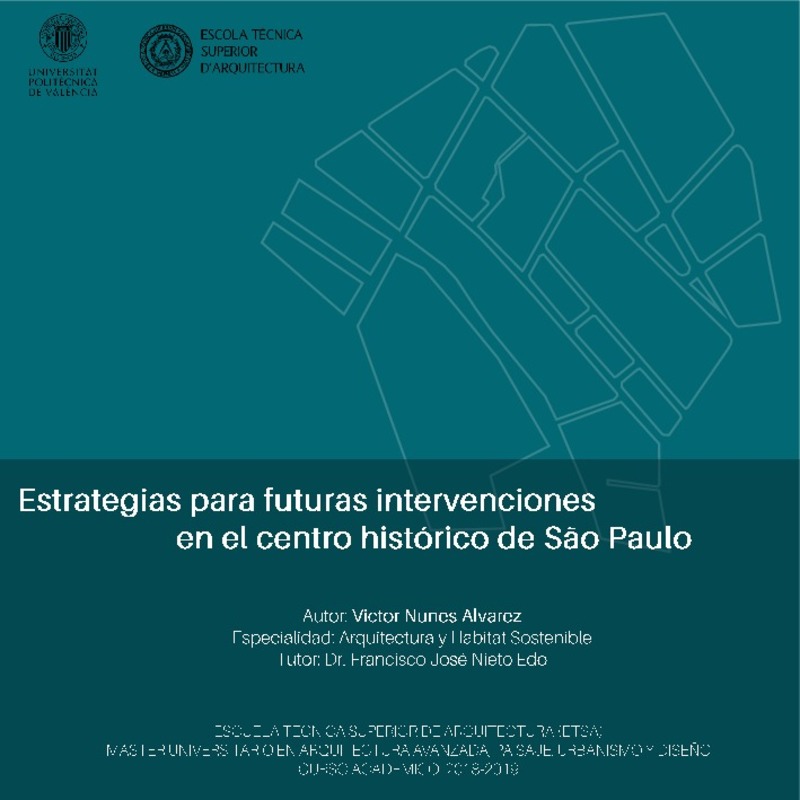|
Resumen:
|
[ES] Las grandes ciudades de América Latina sufren con sus crecimientos muy acelerados que acaban desorganizando la ciudad y generando una gran desigualdad social. Los centros históricos acaban sufriendo con ese crecimiento ...[+]
[ES] Las grandes ciudades de América Latina sufren con sus crecimientos muy acelerados que acaban desorganizando la ciudad y generando una gran desigualdad social. Los centros históricos acaban sufriendo con ese crecimiento acelerado por la creación de distintas centralidades en la misma ciudad, además de la creación de distintos barrios más estructurados y con las clases sociales específicas. Muchos arquitectos y urbanistas luchan con el intento de recuperar los centros históricos de las ciudades, analizando sus historias de desarrollo para proponer propuestas de intervención más correctas para cada caso. Este trabajo investiga estrategias de regeneración urbana y de reciclaje del espacio público para el área histórica de la ciudad de São Paulo, que hasta los días de hoy posee en sus vías edificios históricos que nos muestran cómo era la ciudad en los años anteriores. También estudia, cómo podría insertarse estrategias actuales en un área con una arquitectura urbana ya consolidada. El lugar de estudio es el barrio de la Sé en el centro histórico de São Paulo, donde al pasar de los años fue sufriendo transformaciones, la tranquila Vila de Piratininga donde se instalaron los jesuitas para la alfabetización y catequización de los indios, hoy alberga la mayor concentración de personas de la ciudad, además de grandes edificios que se transformaron en oficinas o depósitos. Sin embargo, hasta los días de hoy el barrio de la Sé contiene espacios urbanos antiguos y edificios de las primeras construcciones que se realizaron en el barrio. Por lo tanto, el desafío de este trabajo es realizar estrategias que puedan ser utilizadas para futuras intervenciones en el área central, que respete la historia y mejore el barrio.
[-]
[EN] Latin America's big cities suffer with their very accelerated growths that end up disorganizing the city and generating a great social inequality. Historic centers end up suffering from this accelerated growth due to ...[+]
[EN] Latin America's big cities suffer with their very accelerated growths that end up disorganizing the city and generating a great social inequality. Historic centers end up suffering from this accelerated growth due to the creation of different centralities in the same city, as well as the creation of different more structured neighborhoods with specific social classes. Many architects and urban planners struggle with the attempt to recover the historic centers of cities, analyzing their development histories in order to propose more correct intervention proposals for each case. This work investigates strategies of urban regeneration and recycling of public space for the historical area of the city of São Paulo, which to this day has in its roads historical buildings that show us what the city was like in previous years. It also studies how current strategies could be inserted in an area with an already consolidated urban architecture. The place of study is the Sé neighborhood in the historical center of São Paulo, where over the years it was suffering transformations, the quiet Vila de Piratininga where the Jesuits settled for literacy and catechization of the indigenous, today houses the largest concentration of people in the city, in addition large buildings that were transformed into offices or warehouses. However, to this day the Sé district contains old urban spaces and buildings from the first constructions made in the district. Therefore, the challenge of this work is to develop strategies that can be used for future interventions in the central area, respecting history and improving the neighborhood.
[-]
|







